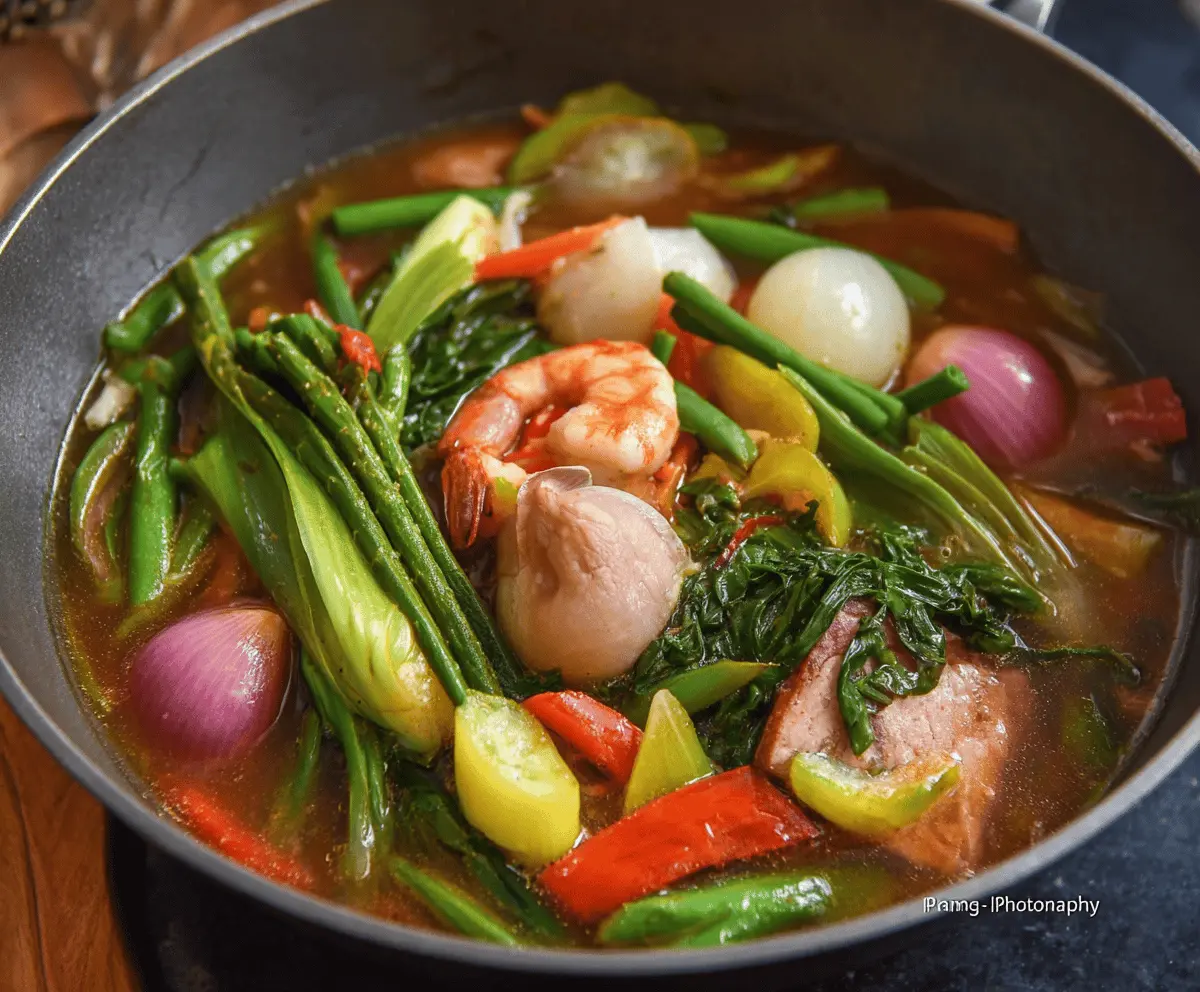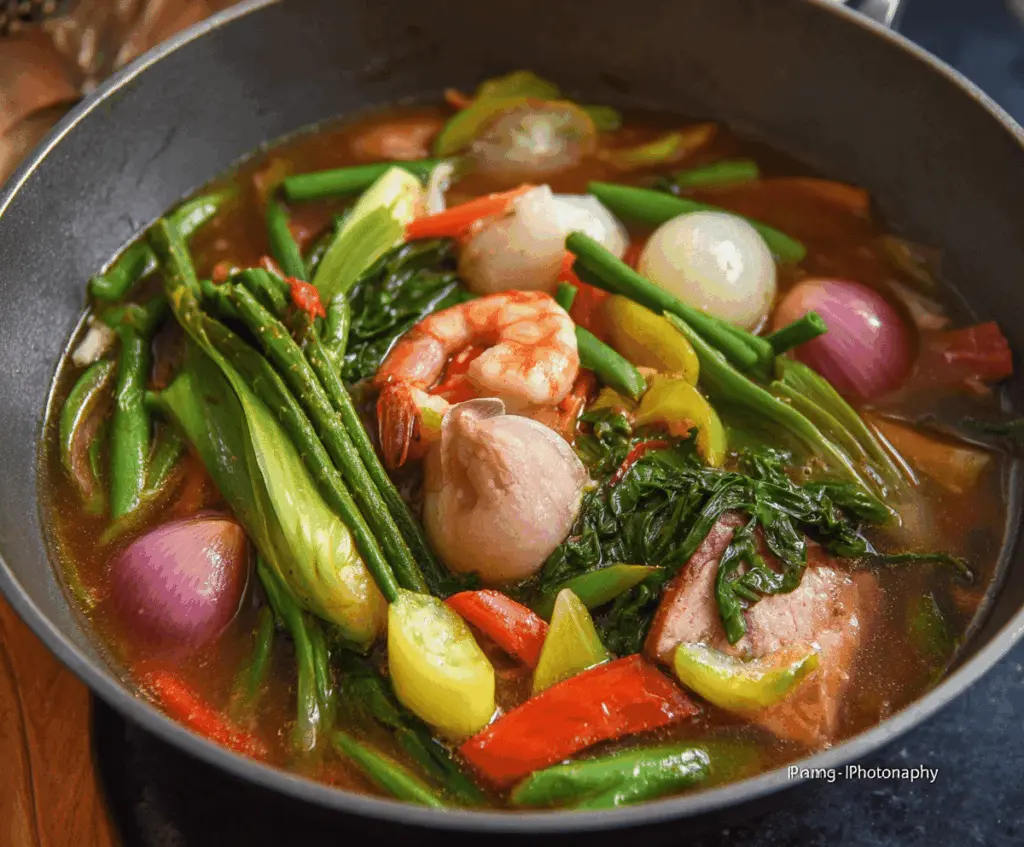Sinigang is a warm, sour soup that is a big favorite in Filipino homes. It’s usually made with meat, like pork or shrimp, and fresh veggies for a tasty twist!
The sour flavor comes from tamarind, and it makes every spoonful comforting. I like to pair it with rice—you can’t go wrong with that combo! 😊
Key Ingredients & Substitutions
Pork: Pork shoulder is great for its tenderness, but you can use belly for more flavor. If you prefer seafood, shrimp is also a delicious option for “Sinigang na Hipon.” Both choices work perfectly!
Tamarind: Traditional sinigang uses fresh tamarind, but tamarind paste or a soup base mix is more convenient. If you can’t find tamarind, try using lime or lemon juice for a different sour note—just add to taste!
Vegetables: Radish is optional, but it adds a nice crunch. If you can’t get taro, potatoes work just as well. You could also switch out mustard greens for bok choy or any leafy greens you like.
Fish Sauce: Fish sauce gives a unique umami flavor. If you’re looking for a vegetarian option, use soy sauce, adjusting the amount to suit your taste.
How Do I Get the Perfect Tender Meat in Sinigang?
The key to tender meat in sinigang is patience. Start by bringing the water and meat to a good boil, then lower the heat and let it simmer gently. This slow simmering breaks down the meat fibers without making them tough.
- After adding the pork, allow it to simmer for 45 minutes to an hour, keeping an eye on it.
- Feel free to check the tenderness by poking a chunk with a fork—you want it to easily pierce through.
By following these tips, you’ll have a comforting bowl of sinigang that’s packed with flavor and warmth. Enjoy every spoonful!

How to Make Sinigang (Filipino Sour Soup)
Ingredients You’ll Need:
For the Soup:
- 1 lb pork shoulder or belly, cut into chunks (or use shrimp for Sinigang na Hipon)
- 8 cups water
- 1 medium onion, quartered
- 2 medium tomatoes, quartered
- 1 cup tamarind paste or 1 packet tamarind soup base mix
For the Vegetables:
- 1 cup radish, sliced (optional)
- 1 cup string beans (sitaw), cut into 2-inch pieces
- 1 cup eggplant, sliced
- 1 to 2 long green chili peppers (siling haba)
- 1 cup mustard greens or spinach (or kangkong/water spinach)
- 1 cup taro root or potatoes, peeled and cut into chunks (optional)
- 1 medium green or yellow bell pepper, sliced
For Seasoning:
- 1 tablespoon fish sauce (patis), or to taste
- Salt to taste
How Much Time Will You Need?
This hearty dish takes about 1 hour to prepare and cook, with additional time to enjoy with your family. Most of the time is spent simmering the pork to get it nice and tender. It makes a perfect meal for the whole family!
Step-by-Step Instructions:
1. Preparing the Broth:
In a large pot, combine the water, pork chunks, onion, and tomatoes. Bring everything to a boil over medium-high heat. Once boiling, reduce the heat to a simmer. While it simmers, skim off any foam or scum that rises to the top, so you have a clean broth.
2. Cooking the Pork:
Let the broth simmer for about 45 minutes to 1 hour. This will make the pork tender and infuse the flavors into the soup.
3. Adding Tamarind Flavor:
Once the pork is cooked, add the tamarind paste or soup base mix to the broth. Stir well to mix everything together, getting that tangy flavor blended in!
4. Mixing in the Root Vegetables:
If you’re using potatoes or taro root, add them now to the pot and let them cook for about 10 minutes, until they begin to soften.
5. Adding More Veggies:
Next, toss in the radish, eggplant, string beans, and chili peppers. Cook these veggies for an additional 5 to 7 minutes, until they are tender but still crisp.
6. Seasoning the Soup:
Add the fish sauce and salt to taste. This will enhance the flavors even more!
7. Finishing Touches:
Finally, add the mustard greens or spinach and bell pepper. Cook for just another 2 minutes until the greens are wilted. Remember, you can adjust the sourness or saltiness by adding more tamarind or fish sauce as you like!
8. Serving the Dish:
Serve your delicious Sinigang hot with a side of steamed white rice. Each bowl is a refreshing and warming experience—perfect for any gathering or simply to enjoy at home!
Enjoy every delightful spoonful of this hearty Sinigang soup!

Can I Use Different Meats for Sinigang?
Absolutely! While pork is traditional, you can also use beef, chicken, or shrimp. Just adjust the cooking times accordingly—shrimp cooks quickly, so add it in the last few minutes of cooking!
What Can I Use Instead of Tamarind?
If tamarind isn’t available, you can substitute it with fresh lime or lemon juice. Start with 1-2 tablespoons and adjust according to your taste preference for sourness.
How Do I Store Leftovers?
Store any leftover Sinigang in an airtight container in the fridge for up to 3 days. To reheat, gently warm it on the stove or in the microwave, adding a bit of water if it thickens too much.
Can I Add More Vegetables?
Yes! Sinigang is versatile, so feel free to throw in your favorite vegetables. Just make sure they have similar cooking times to ensure everything cooks evenly. Good options include bok choy, zucchini, or even mushrooms.



